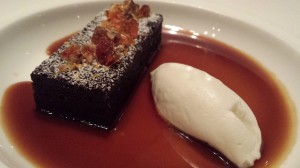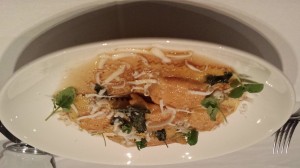An evening of fine dining at Nota Bene

Somewhat serendipitously, our venue of choice for Winterlicious 2015 was just down the street from Old Osgoode Hall. David Lee’s award winning restaurant Nota Bene sits just west of University Avenue, at the gateway to Queen West. We were greeted by several smiling faces at the front, and the free coat check, while not exactly a surprise, was a nice touch. The decor was definitely on the upscale side, but by no means snobbish; a couple of students on a date didn’t feel out of place. Our waitress was cheerful and sincere, and didn’t treat us Winterlicious-ers as second class patrons, despite our double tap water beverage order. Not long after we had placed our orders, we were treated to warm slices of house made sourdough with a thick, crunchy crust and pillowy soft interior. The bread came with a little carafe of nice olive oil, which was cool and different, but in the end, we both agreed that butter would have been better.
Erin’s appetizer was smoked Nova Scotia salmon and pickled beets on a bed of arugula. The big arugula leaves proved a bit cumbersome to eat, but the salad was delicious, particularly the beets which were beautifully sweet and sour at the same time. My appetizer was a terrine made from duck, foie gras, and cherries, with a big cracker on the side, some crisp, bitter endive, apple puree, and pistachio granola. The dish was exceptionally well balanced; the rich, savoury terrine offset perfectly by the other elements.
I should just quickly note, as some may know, the topic of foie gras is somewhat controversial. The practice of producing foie gras involves force feeding ducks so the liver becomes larger and fattier. I have done a bit of research into the process, and while this may do little to comfort the vehement animal rights activists among us, I can at least say the process isn’t nearly as gruesome as it sounds. Anthony Bourdain visited a duck farm on an episode of his show “No Reservations,” and the farmer shows you exactly what happens. The entire process takes only a few seconds per day and, other than that, the ducks waddle around free range looking as healthy and happy as can be. All I can say is that there was nothing inhumane or cruel about the process at that farm. Obviously I can’t verify that for Donald or Daffy from my particular appetizer, but I just wanted to say something to the people who might cringe at reading about my choice… MOVING ON.

Erin’s main course was a sweet potato and ricotta ravioli with chestnuts and fried sage leaves. The pasta was absolutely perfect having the soft, yet chewy texture of handmade dough, and the filling was not too sweet and velvety smooth. My main course was called “Tongue and Cheek,” and it was exactly that. Beef cheek might sound a bit strange, but really it’s just a tough, flavourful piece of meat like brisket or short rib; very tender and tasty once you give it a bit of TLC. The tongue was veal and was also not nearly as scary as you might think. It was deliciously spiced, and the texture wasn’t weird at all. The meat was paired with what I could only describe as a big, grown-up tater tot: a cheesy, spicy potato fritter. The whole dish was sprinkled with a bit of cojita cheese and some cilantro. I’ve never had anything like it. The dish had a vaguely Mexican undercurrent to it in terms of the spices and the cheese as well as the use of more uncommon cuts of meat. I was in Mexico last year, and where I was it wasn’t uncommon to come across incredible tacos featuring similar cuts. The use of uncommon cuts of meat has become particularly fashionable in fine dining restaurants, colloquially referred to as the “tongue to tail” movement. A Toronto restaurant which is especially well known for creativity in that department is called Black Hoof, which I haven’t had the opportunity to try yet, but hopefully I will someday. I like the idea of using every bit of an animal, and it gets to the heart of why I love food and cooking so much. Anthony Bourdain talks about cooking, especially what you might call “peasant food,” as a kind of alchemy. While the rich people made off with all the best cuts of meat, the poorer folks were always left with the other bits. But with time and love, they created amazing things. Anybody can grab a stopwatch and throw a steak on the barbecue and it will be great, but to transform something tough or maybe a bit, unsightly, into something delicious – that takes skill and devotion. Food like that is soulful. It’s interesting to reflect and notice that many of our favourite foods in North America actually have their roots in exactly that, perhaps the greatest example being the humble hot dog. Now I’m not saying hot dogs are fine dining, but the sense of making something beautiful out of the stuff that nobody wants is pretty cool.
For dessert, Erin picked a clementine sorbet. The sorbet itself was mind-blowing, but the presentation was a bit strange. It came in a very big glass bowl, the kind of standard issue bowl that you would use for mixing things, not a serving bowl. The sorbet also had a really big shard of what they called “yogurt crisp” stuck into it – a sort of wafer. Erin felt like it was not really necessary, and it looked especially weird in the giant glass bowl. My dessert was a total home run: a dense, dark chocolate brownie sitting on a pool of espresso caramel with some whipped cream on the side, and sprinkled with amber pieces of pecan praline. It was unbelievable. We finished our amazing desserts, and with that, paid the bill, grabbed our coats, and stepped back out into the cool night air.
